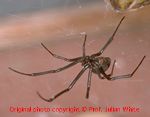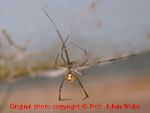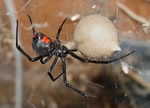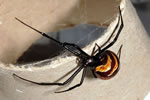|
Latrodectus mactans
|
![Latrodectus mactans ( Black Widow Spider ) [ Original photo copyright © Dr Julian White ]](images/spiders/SPP000611.jpg)
|
|
Suborder: Araneomorphae
|
|
Family: Theridiidae
|
|
Genus: Latrodectus
|
|
Species: mactans
|
Common Names
Black Widow Spider
|
Region
North America
|
Countries
Canada, United States of America
|
|
|
|
|
Taxonomy and Biology
|
|
No information available for Taxonomy and Biology
|
|
|
|
Venom
|
General: Venom Neurotoxins
Excitatory neurotoxins (alpha-latrotoxins)
|
General: Venom Myotoxins
Not present
|
General: Venom Procoagulants
Not present
|
General: Venom Anticoagulants
Not present
|
General: Venom Haemorrhagins
Not present
|
General: Venom Nephrotoxins
Not present
|
General: Venom Cardiotoxins
Not present
|
General: Venom Necrotoxins
Not present
|
General: Venom Other
Not present or not significant
|
|
|
|
Clinical Effects
|
General: Dangerousness
Severe envenoming possible, potentially lethal
|
|
General: Rate of Envenoming: 10-20%
|
|
General: Untreated Lethality Rate: Unlikely to prove lethal
|
General: Local Effects
Initially minor "sting", then progressively severe local pain ± sweating & erythema/blanching.
|
General: Local Necrosis
Does not occur, based on current clinical evidence
|
General: General Systemic Effects
Unknown
|
General: Myotoxicity
Insufficient clinical reports to know, but related species very rarely cause mild myolysis (CK up to 1500IU/l).
|
General: Coagulopathy & Haemorrhages
Does not occur, based on current clinical evidence
|
General: Renal Damage
Does not occur, based on current clinical evidence
|
General: Cardiotoxicity
Does not occur, based on current clinical evidence
|
General: Other
Occasionally cause headache, arthralgias, tremors, psychosis, severe trismus, dysuria, dyspnoea.
|
|
|
|
First Aid
|
|
Description: First aid for Widow Spider Bites (includes Australian red back spider)
|
Details
1. After ensuring the patient and onlookers are no longer at risk of further bites by the spider, the bitten person should be reassured and persuaded to lie down and remain still. Some will be terrified, fearing sudden death and, in this mood, they may behave irrationally or even hysterically. The basis for reassurance is the fact that many bites do not result in envenoming, death is a very rare outcome, and the effectiveness of modern medical treatment.
2. The bite wound should not be tampered with in any way.
3. Some victims find the application of a local cold pack may relieve local pain.
4. Do not apply a local bandage, tourniquet, or cut or suck or incise the wound or apply electric shock. Application of local heat has not proved beneficial.
5. If there is any impairment of vital functions, such as problems with respiration, airway, circulation, heart function, these must be supported as a priority. In particular, both airway and respiration may be impaired, requiring urgent and prolonged treatment, which may include the mouth to mask (mouth to mouth) technique of expired air transfer. Seek urgent medical attention.
6. If the offending spider has been killed or caught it should be brought with the patient for identification.
7. Avoid peroral intake, other than clear fluids, in the first 6 hours, absolutely no alcohol. No sedatives outside hospital. If there will be considerable delay before reaching medical aid, measured in several hours to days, then give clear fluids by mouth to prevent dehydration.
8. Most traditional, and many of the more recently fashionable, first aid measures are useless and potentially dangerous. These include local cauterization, incision, excision, amputation, suction by mouth, vacuum pump or syringe, combined incision and suction ("venom-ex" apparatus), injection or instillation of compounds such as potassium permanganate, phenol (carbolic soap) and trypsin, application of electric shocks or ice (cryotherapy), use of traditional herbal, folk and other remedies including the ingestion of emetic plant products and parts of the snake, multiple incisions, tattooing and so on.
|
|
|
|
Treatment
|
Treatment Summary
Widow spider bites are mostly minor and even significant envenoming is unlikely to be lethal, so after a 6 hr observation, asymptomatic patients can be discharged. Symptomatic patients should be considered for IM or IV antivenom therapy, as this is the only effective treatment for envenoming.
|
Key Diagnostic Features
Bite felt as "sting", delayed (10+min) local pain ± sweating, then regional pain, tender draining lymph nodes, nausea, hypertension, malaise.
|
General Approach to Management
While most cases will be minor, not requiring admission, some cases will be more severe, requiring admission and treatment, so assess carefully before early discharge.
|
Antivenom Therapy
Antivenom only required for major regional or systemic envenoming.
|
| 1. Antivenom Code: IAmNIA06
|
|
Antivenom Name: Anti Latrodectus antivenom
|
Manufacturer: Instituto Nacional de Produccion de Biologics
A.N.L.I.S.
|
|
Phone: ++54-11-4303-1806 (to 11)
|
Address: Avdo. Velez Sarsfield 563,
CP 1281 Buenos Aires,
|
|
Country: Argentina
|
| 2. Antivenom Code: IAuCSL05
|
|
Antivenom Name: Red-backed spider antivenom
|
|
Manufacturer: CSL Limited
|
Phone: ++61-3-9389-1911
Toll free: 1800 642 865
|
Address: 45 Poplar Road
Parkville
Victoria 3052
|
|
Country: Australia
|
| 3. Antivenom Code: IAmMSD01
|
|
Antivenom Name: Antivenin ( Latrodectus mactans )
|
|
Manufacturer: Merck Sharp and Dohme International
|
|
Phone: ++1-800-396-6250
|
Address: One Merck Drive
P.O. Box 100
Whitehouse Station, NJ 08889-0100 USA
|
|
Country: U.S.A.
|
|
|
|
Images
|

|

|

|

|
|
|
|
Latrodectus mactans ( Black Widow Spider ) [ Original photo copyright © Dr Julian White ]
|
Latrodectus mactans ( Black Widow Spider ) [ Original photo copyright © Dr Julian White ]
|
Latrodectus mactans ( Black Widow Spider ) [ Original photo copyright © Chuck_Evans-2007-CC BY-SA-2.5 ]
|
Latrodectus mactans ( Black Widow Spider ) [ Original photo copyright © Fritz_Geller_Grimm-2009-CC BY-SA 3.0 ]
|
|
|
|
|
|



